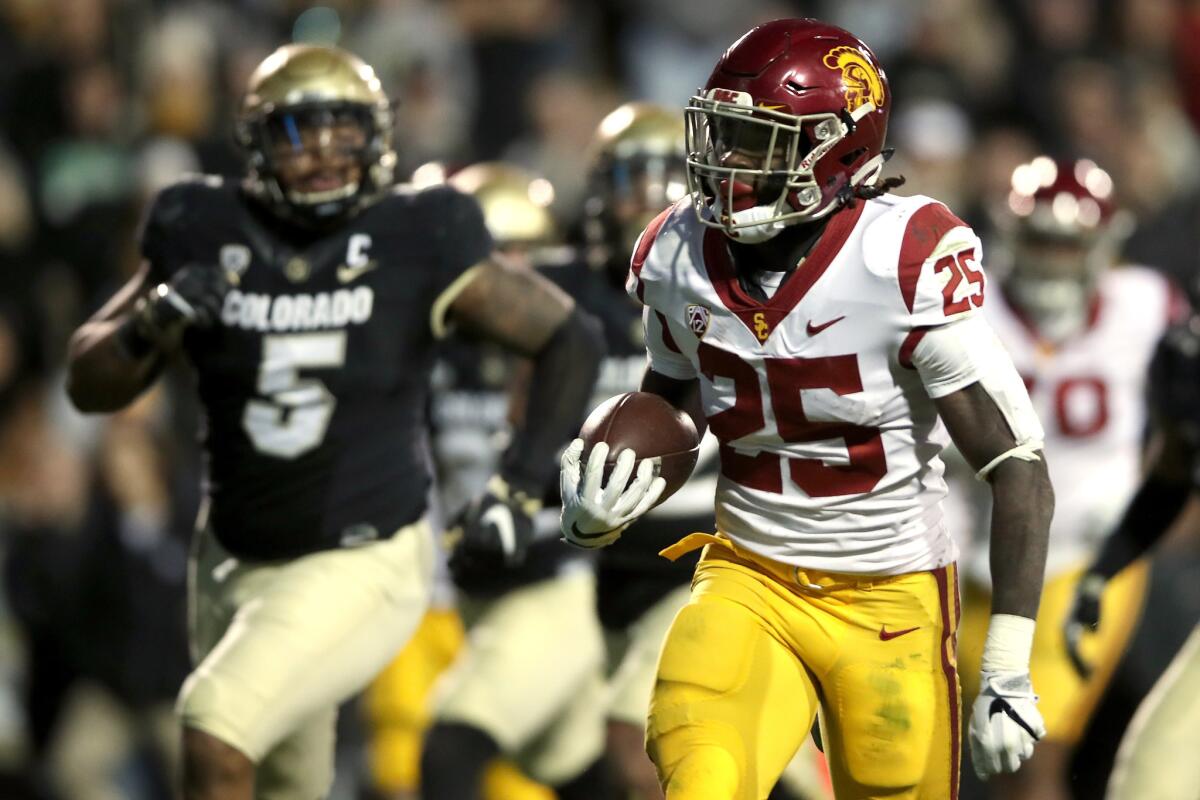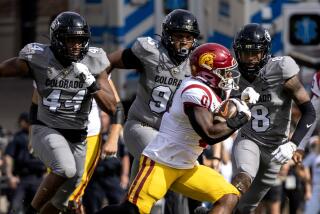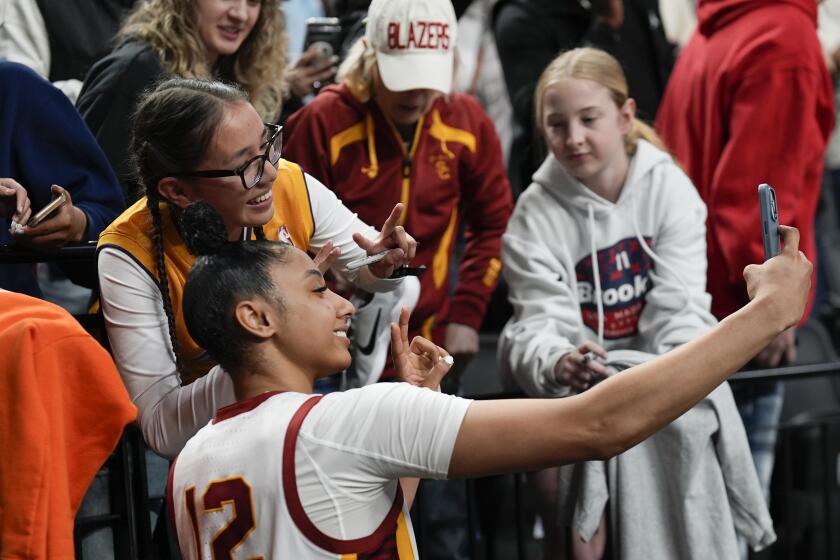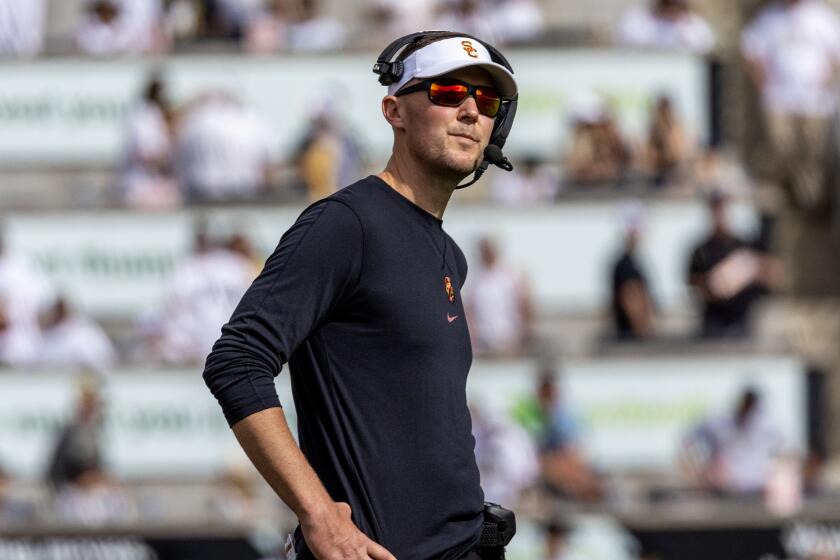USC’s Ronald Jones II improves his game, avoids the spotlight

Given a choice in the matter, Ronald Jones II would prefer to fly under the radar for the next few weeks.
If it were up to him, all the talk surrounding the Cotton Bowl showdown between No. 8 USC and No. 5 Ohio State would focus on the quarterbacks or maybe the defenses.
No one would make a fuss about the tailback who has quietly put together one of the most productive careers in the history of a school known as Tailback U.
“I like to play silently,” Jones said.
So far, so good.
In the days since the bowl matchups were announced, Ohio State coaches and players have commented mostly on USC’s football tradition and on Sam Darnold’s arm.
“He’s a tremendous talent,” linebacker Chris Worley said of the Trojan quarterback.
But Jones could become a hot topic as the Buckeyes study more videotape from this season.
The 6-foot, 200-pound junior from Texas ranks eighth in the nation with 1,486 rushing yards and fifth-best with 18 touchdowns on the ground.
His career total of 3,555 yards places him fifth on USC’s all-time list, just behind Charles White, Marcus Allen, Anthony Davis and Ricky Bell. Just ahead of O.J. Simpson, Mike Garrett and Reggie Bush.
“He’s a freak,” Arizona coach Rich Rodriguez said earlier this year. “He gets to full speed in a hurry. His fast is fast.”
Maybe Jones hasn’t garnered as much attention as the other tailbacks on the USC list because the spotlight has burned so brightly on Darnold. Or because he isn’t much of a talker.
It almost seemed as if he snuck up on college football, coming off the bench as a freshman in 2015, putting together a string of decent but not splashy performances.
His natural acceleration and change of direction did not truly emerge until the ninth game when he ran for 177 yards against Arizona. By season’s end, Jones led the team with 987 yards.
Last fall, he ran for 223 yards against California and 171 against Oregon on the way to 1,082-yard season. Still, the coaches considered him a work in progress.
“I looked at him and saw a rough mold of clay,” said Deland McCullough, who joined USC as the running backs coach last spring. “Some great clay to work with, but there were some things we needed to smooth out.”
If Jones is reticent, McCullough is the opposite, talkative and energetic. He came to USC from Indiana where he helped build Tevin Coleman and Jordan Howard into NFL stars.
Trojan running backs soon learned that he was the Inspector Gadget of football assistants.
Determined to limit turnovers, he made them carry a ball filled with water in practice. He poked at them with a boxing glove fixed to a pole and had them run with another football that had a rope attached so he could yank on it.
“At the end of the day, the drills I have, it’s just thinking ‘What’s the best thing we can do to simulate game circumstances?’” he said.
When McCullough decided that Jones needed to fix “some things,” the list went way past ball security. Over the spring and summer, they worked on recognizing blitzes and running cleaner routes.
And, for a back who had relied on speed, adding toughness was a must.
“It was demanded in our room that we’re going to be guys who break tackles, who run with great pad level, who won’t get tackled by the first guy,” McCullough said. “Even on a one-yard run, it needs to be a hard-fought one yard.”
This change required more than an attitude adjustment. Jones spent more time in the weight room and less time at fast-food counters.
“I cut out some of the late-night snacks,” the tailback said.

Hard work added muscle. Confidence changed the way he attacked the line of scrimmage.
“In my freshman and sophomore years, the defense would get me with ankle biters,” he said. “Now I’m just running through those arm tackles.”
The difference was evident when he rushed for 159 yards in the season opener against Western Michigan. The next week, he gained 116 against Stanford.
“Ronald Jones runs through contact and he’s got great ability to cut and get vertical,” Cardinal coach David Shaw said.
After a tough midseason game at Notre Dame — none of the Trojans looked good that night — Jones rebounded with big performances against Arizona State, Arizona and Colorado.
As the yardage piled up, McCullough was just as pleased by the little things. He recalls a play from the first overtime against Texas, when Jones gave his quarterback time by picking up a blitzing Texas linebacker.
“Just stoned him in the hole,” McCullough said. “We threw a touchdown on that pass.”
As for the lack of hype surrounding Jones, that doesn’t seem to bother neither the player nor his coach.
“Can’t control what people on the outside say,” McCullough said. “But when the season is completely over, when you look at it, you’ll see Ronald Jones is easily one of the top two or three running backs in the country.”
The Cotton Bowl will provide a national stage against a top-rated opponent.
The Buckeyes rank eighth in total defense and seventh against the run, holding opposing rushers to 108.8 yards a game. That would be 15 yards fewer than the 123.8 yards Jones averages.
“They’ve shown the ability to go against teams like Wisconsin, smash-mouth running teams,” USC offensive coordinator Tee Martin said, adding: “Up front, they’re good versus the run and they’ve got a good pass rush.”
All of which should give Jones a chance to show how much he has grown as both a runner and a blocker.
Though he hasn’t committed to leaving school early for the NFL draft, saying that decision will come later, the Cotton Bowl could be his last game as a Trojan.
“We have a chance to go make a statement,” he said.
The quiet tailback might actually make some noise.
Follow @LAtimesWharton on Twitter
More to Read
Go beyond the scoreboard
Get the latest on L.A.'s teams in the daily Sports Report newsletter.
You may occasionally receive promotional content from the Los Angeles Times.







